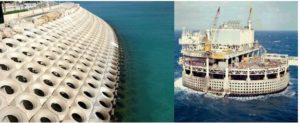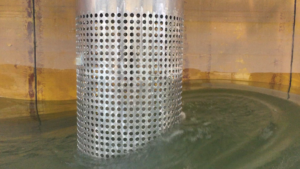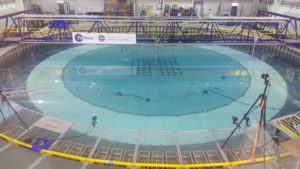Model Tests with a Novel Floating Wind Turbine Concept
Dr Ed Mackay & Prof. Lars Johanning, Offshore Renewable Energy Group

Floating offshore wind energy has been identified as being able to provide a significant contribution to meeting future renewable energy generation targets. Compared to traditional offshore wind turbines, which are fixed to the seabed, floating turbines can access deeper waters and areas with a higher wind resource. Current floating wind turbines are at the pre-commercial stage, with small arrays of up to five turbines being demonstrated. The cost of floating offshore wind turbines is currently significantly higher than fixed offshore wind. One of the main areas identified for reducing the cost of the structure is in the design of the platform. The platform must be designed to withstand large wave loads and keep the wind turbine as stable as possible. Large platform motions lead to reduced energy yield and increased loads on the wind turbine and drive train.
As part of the EPSRC funded RESIN project, the University of Exeter has been working with Dalian University of Technology (DUT) in China to investigate the use of porous materials in the floating platform for an offshore wind turbine, as a passive means of reducing platform motions. Porous materials are commonly used in offshore and coastal structures such as breakwaters or offshore oil platforms. As a wave passes through the porous material, energy is dissipated, reducing the wave height and wave-induced forces. The question posed by the RESIN project is: can porous materials be beneficial for floating offshore wind?

The project has investigated this question using a combination of physical and numerical modelling. A range of analytical and numerical models have been developed [1-3] and validated against scale model tests in wave tanks. Two tests campaigns were conducted at the large wave flume at DUT in the summers of 2018 and 2019. The initial tests last year considered simple cases with flat porous plates with various porosities and hole sizes [4] and tests with fixed porous cylinders. These tests were used to validate the numerical predictions in a range of simple scenarios and gain an understanding of the effect of the porosity on the wave-induced loads.

Following the successful validation of the numerical models with simple fixed structures, a design was developed for a 1:50 scale model of a floating turbine, which could be tested with and without external porous columns. The model was tested at DUT this summer and further tests were conducted in the FlowWave tank at the University of Edinburgh this autumn. The test results showed that the motion response could be reduced by up to 40% in some sea states by adding a porous outer column to the platform. Work is ongoing to analyse the test results and optimise the design a platform using porous materials. However, initial results indicate that using porous materials in floating offshore wind turbines offers potential for reducing the loading on the turbine and mooring lines and improving energy capture.


Thanks Ed!
To keep up to date with the Renewable Energy team, give them a follow on Twitter @Renewables_UoE
For information on the Offshore Renewable Energy research group, check out their webpages.
References
- Mackay EBL, Feichtner A, Smith R, Thies P, Johanning L. (2018) Verification of a Boundary Element Model for Wave Forces on Structures with Porous Elements, RENEW 2018, 3rd International Conference on Renewable Energies Offshore, Lisbon, Portugal, 8th – 10th Oct 2018.
- Feichtner A, Mackay EBL, Tabor G, Thies P, Johanning L. (2019) Modelling Wave Interaction with Thin Porous Structures using OpenFOAM, 13th European Wave and Tidal Energy Conference, Napoli, Italy, 1st – 6th Sep 2019.
- Mackay E, Johanning L, (2019). Comparison of Analytical and Numerical Solutions for Wave Interaction with a Vertical Porous Barrier. Ocean Engineering (submitted)
- Mackay E, Johanning L, Ning D, Qiao D (2019). Numerical and experimental modelling of wave loads on thin porous sheets. Proc. ASME 2019 38th International Conference on Ocean, Offshore and Arctic Engineering OMAE2019, 2019, pp. 1-10.
#ExeterMarine is an interdisciplinary group of marine related researchers with capabilities across the scientific, biological, medical, engineering, humanities and social science fields.
Find us on: Facebook : Twitter : Instagram : LinkedIn
If you are interested in working with our researchers or students, contact Emily Easman or visit our website!
